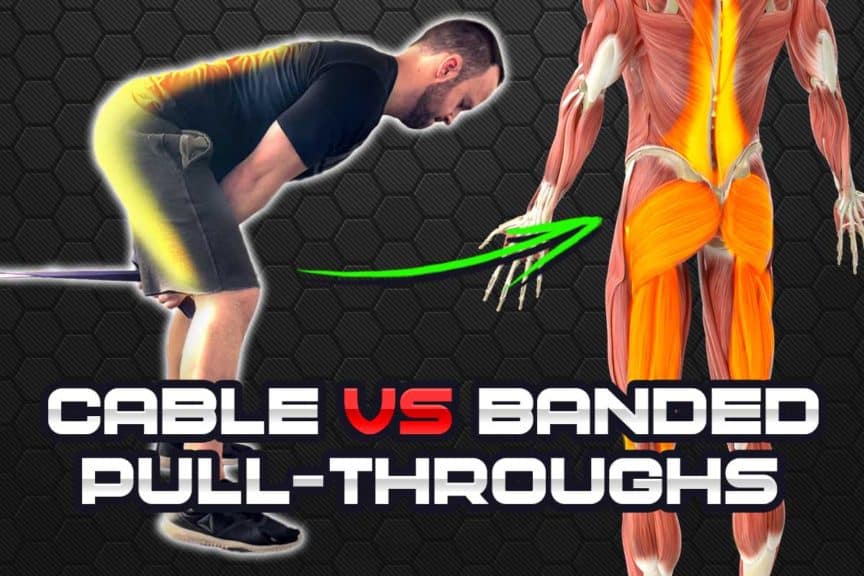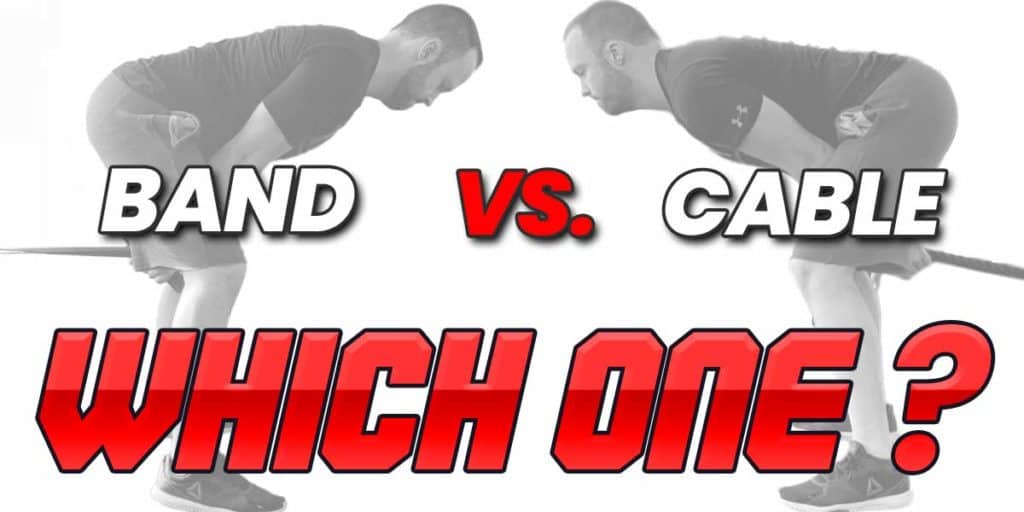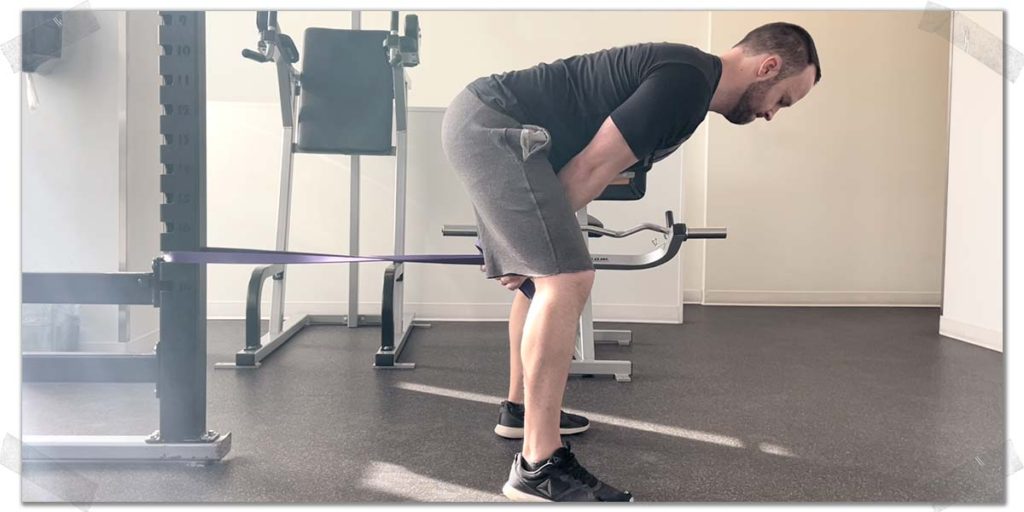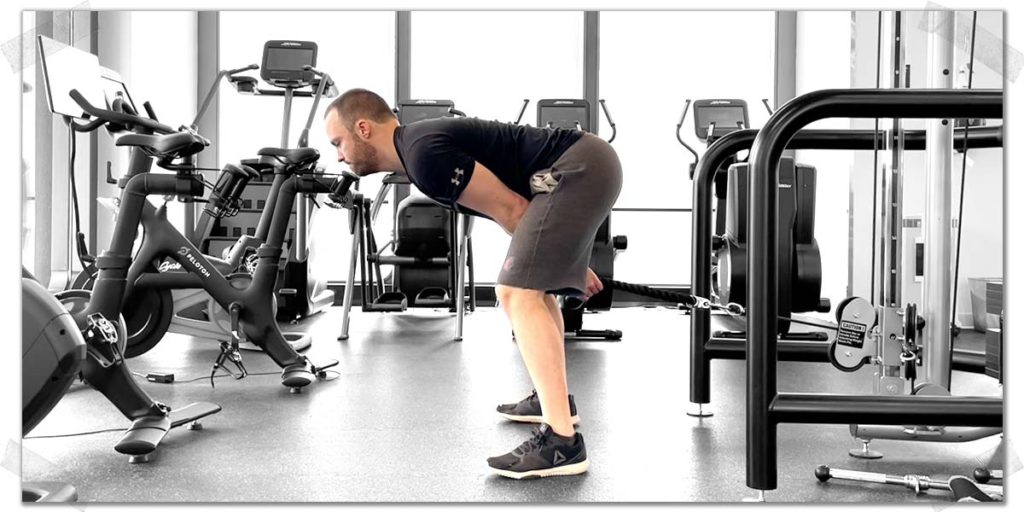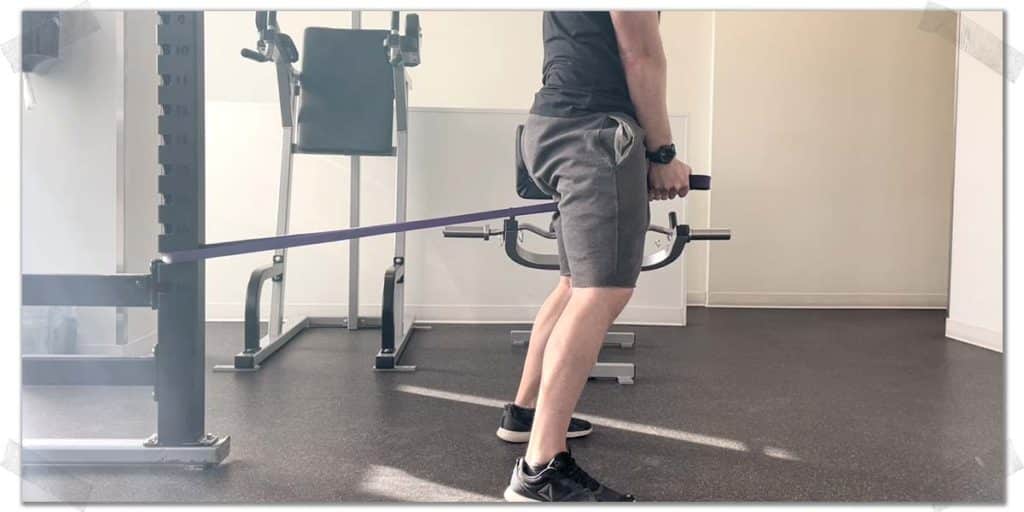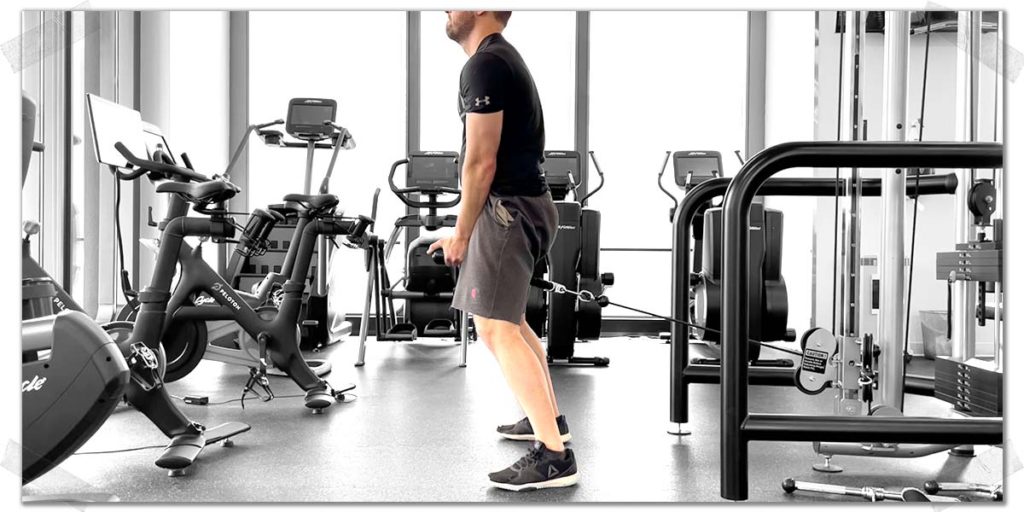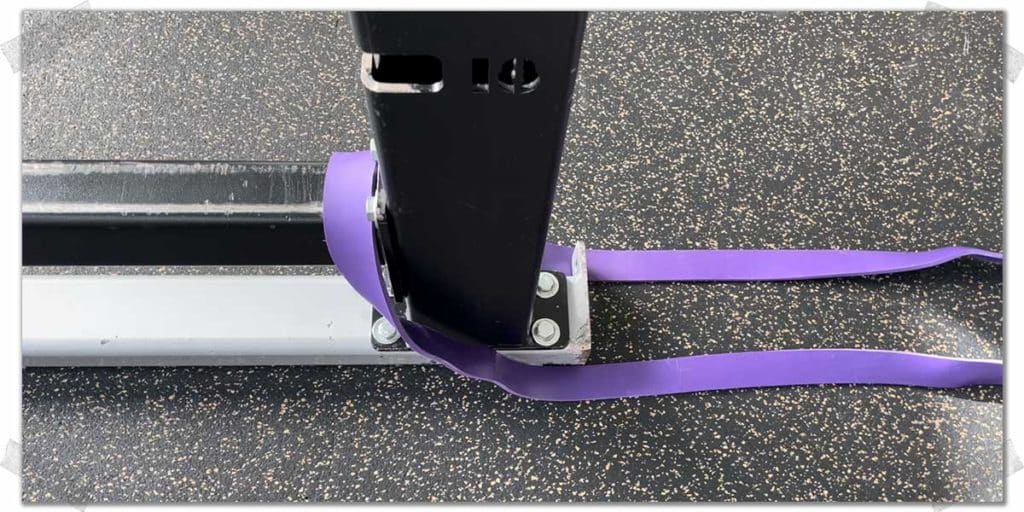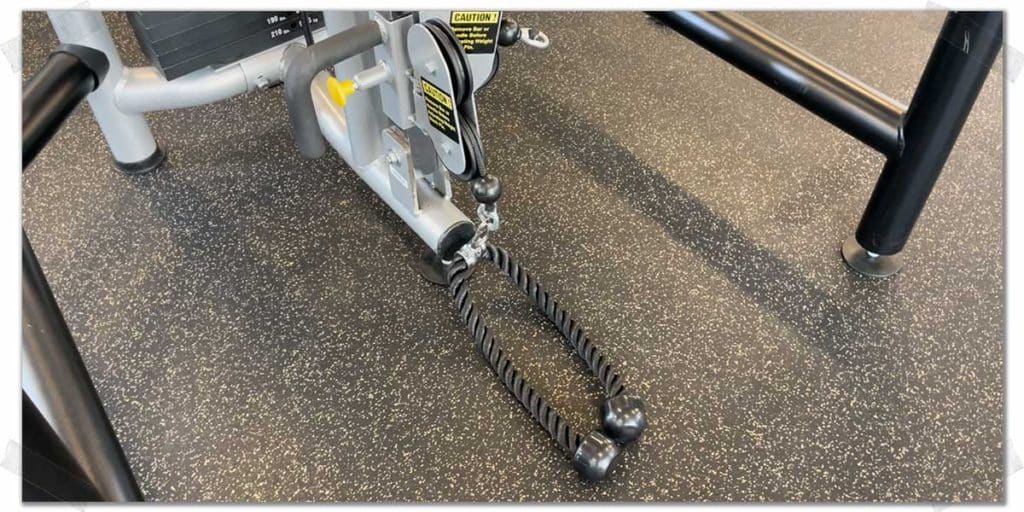The pull-through is a brilliant exercise that can build a bulletproof backside on those who choose to perform them. Sometimes lifters perform them on traditional gym equipment, specifically with a cable stack, while other times, you’ll see folks perform them with giant rubber bands. But is there really a difference between the two?
While they may look pretty similar, there actually are some rather notable differences that exist between cable pull-throughs and banded pull-throughs.
Cable pull-throughs offer a fixed resistance using a weight stack and are typically performed at a slower rate of movement. Banded pull-throughs offer an accommodating resistance and can be done at slow, moderate or high rates of speed, based on training needs.
The result of these differences is their applicability to specific styles of training or training goals that you may have. Therefore, knowing the ins and outs of each version can help you select the best type of pull-through to perform based on your training needs or goals.
So, if you want the full breakdown of what makes each version of the pull-through unique and effective, keep on reading!
ARTICLE OVERVIEW (Quick Links)
Click/tap on any headline below to jump to that section of the article!
• The similarities
• Spotting the differences
• When to use cable pull-throughs
• When to use banded pull-throughs
Disclaimer: While I am a physical therapist, I am not YOUR physical therapist. As a result, I cannot tell you whether or not any treatments or training methodologies mentioned on this website or in this article may or may not be appropriate for you, including performing pull-through exercises. By following any information within this post, you are doing so at your own risk. You are advised to seek appropriate medical advice for any pain you may be experiencing.
Related article: One Hamstring Tighter Than The Other? Here’s Your Solution
The similarities
Yes, there are some notable differences between the two types of pull-throughs, but there are plenty of similarities as well. Whether you perform your pull-throughs using a cable stack or a band, both will work to develop your posterior chain in highly functional ways. It’s worth quickly going over two of the most important similarities between each method of pull-through. Doing so will help you better understand why either of these methods will be highly beneficial for your physical training and functional pursuits.
Similarity 1: The movement pattern
The pull-through — be it performed on a cable machine or with a band — requires flexion (forward bending) of the hip while avoiding flexion of the lumbar spine. This movement is, by definition, the hip hinge. The pull-through also requires a soft bend in the knees that does not increase or decrease throughout the movement (i.e., the knees remain motionless) — locking your knees out while performing this movement is not in your best interests. As a result, the vast majority of the hip hinge results from movement coming from the ball and socket joint within each hip.
As well, the arms remain motionless throughout the entirety of the pull-through/hip-hinging movement; if they’re moving, you’re very likely doing it wrong.
Similarity 2: Targeting of the same muscles
Both versions of the pull-through will target the same set of muscles on the backside of the body, often known as the posterior chain muscles. These muscles primarily include:
- The hamstrings
- The gluteus Maximus
- The spinal erectors
Hence, both versions of the pull-through are lower body exercises that challenge muscles on the backside of the body.
Related article: Six Benefits of Using a Glute-ham Roller (Here’s Why You Need One)
Spotting the differences
While the movement pattern (and the muscles it targets) of either the cable or banded pull-through is the same, there are a couple of critical differences that take place. Being aware of these seemingly subtle differences can help you determine which type of pull-through may be best for you and your training needs, so let’s quickly go through them.
Difference 1: Accommodating vs non-accommodating resistance
This is the biggest difference between the cable and the banded pull-through. While a cable stack offers a fixed amount of resistance throughout the entire movement, the banded pull-through offers what’s known as an accommodating resistance. Accommodating resistance just refers to the amount of resistance changing throughout the exercise.
In the case of the banded pull-through, the movement becomes more challenging (i.e., the resistance continually increases) the more you return to the upright position to complete the pull-through movement. In other words, the more you stretch the band, the more resistance you encounter. There are plenty of times when this type of resistance can be beneficial to a lifter’s/athlete’s training (keep reading if you want to learn more).
Difference 2: Rate of force development
Due to the band’s accommodating nature, the banded pull-through can be used for styles of training that require a faster speed of movement, often referred to as rate of force development (RFD).
If you were to try and perform a cable pull-through in a fast, explosive motion, you’d run into issues involving the lifted portion of the weight stack flying upwards along its track after you completed the movement. Not only would this result in a momentary loss of all tension or resistance, but it would also make for excessive noise along with unnecessary wear and tear being placed on the cable stack apparatus.
With the banded pull-through, you can produce a slow, controlled movement, a rapid, explosive movement, or any speed in between. Both extremes and the speeds in between have their time and place depending on one’s training objectives and individual needs.
When to use cable pull-throughs
Even though the similarities abound between the cable pull-through and the banded version, there are times when selecting the cable pull-through may be more ideal for your needs. What follows are some of the reasons or circumstances for opting for the cable pull-through instead of the banded pull-through.
Factor 1: You need consistent (non-accommodating) resistance
If your current training regimen, training block or general athletic pursuits dictate a greater need for slow, tempo-based movements, or you don’t have any need to perform fast, explosive hip-hinging movements, the cable pull-through is a perfectly suitable option.
If you’re new to performing the movement, a cable machine will suffice just fine for getting familiar with the movement while safely optimizing your technique. Of course, beginners can still learn and perform this movement using a band. Still, since exercises should be performed slowly (whenever possible) when first learning the general movement patterns involved, a cable machine is perfect for beginners to use.
Factor 2: You need ease of access at your training facility
While an appropriate resistance band for pull-throughs takes up virtually zero real estate within the gym and costs very little, there are (quite unfortunately) still plenty of public gyms that don’t have these types of bands within their facility for its members to use.
Sure, you can always buy your own and tuck it away in your gym bag, but if you’d like to save a few bucks, don’t need accommodating resistance, and have no need to perform the hip hinge with an explosive concentric contraction, the cable machine will serve you just fine for your pull-throughs.
Factor 3: You need or want to track your poundage
While bands have plenty of advantages, one of their shortcomings is the inability to quantify and track the amount of resistance you’re using. While you can use thicker or thinner bands, there are times when an individual may want or need to track the specific amount of resistance they’re using for their pull-through.
Strength-based athletes or those trying to track their overall training volume might find the cable machine, therefore, more optimal for their training. This can help them better determine if specific training progress is taking place, help ensure they’re training at an optimal intensity, etc.
When to use banded pull-throughs
While performing pull-throughs on the cable stack can cover the vast majority of your pull-through needs, there are a few key situations or circumstances for which you might be better off performing this exercise using a band. What follows below are three factors that might influence your need to opt for a band over the cable stack.
Factor 1: You require explosive movement speeds for your training
When training for improving power output, performing exercises at lighter loads (but with a higher rate of force production AKA “explosive” training) is a must. Raw, contractile strength of the muscles is one thing, but the ability for those muscles to rapidly produce that contractile strength is another.
Think of the difference between strength and power like a jet taking off from a standard runway vs an aircraft carrier.
So, if your training calls for phases of developing explosive power and you need to perform pull-throughs as part of your exercise regimen, opt for the band rather than the cable machine.
Factor 2: The cable machine is in rough shape
Anyone who has worked out in enough public gyms knows that the cable machines in those facilities can be…well, let’s just say “in less than ideal condition.” You know, you try to do any exercise with it, and the cable and pulley are either incredibly sticky, choppy, or some combination of the two.
Pull-throughs performed on machines with sub-par cable maintenance can be quite annoying or even frustrating. If this is the case for you and the gym you train at, consider grabbing a band (likely your own) and performing your pull-throughs with the band. As an added bonus, you’ll be able to use your band for a plethora of other exercises in addition to just the pull-throughs.
Factor 3: The cable machine is always in use
It happens at seemingly every public gym, especially smaller ones with only one cable machine — it’s always in use. Sure, you could wait around for your chance to hop on or ask to “work in” with the individual currently using it. But, grabbing a band might just be the more practical option, especially if you’re just trying to get some pull-throughs done without an absolute need to perform them with the cable stack.
So, if the machine is constantly in use, consider picking up some bands that you can toss in your gym bag; that way, you can bust them out whenever needing to do some pull-throughs (or other exercises) when the facility’s equipment is being used by other members.
Final thoughts
Both the cable and banded pull-through are outstanding exercises. Few exercises can develop the posterior chain the same way that this exercise can. Whether you opt to perform them with a cable stack or with a band, you really can’t go wrong. There are certain times when you may prefer to opt for one over the other if your situation or training demands call for the need to do so.
Either way, pick what you need or what works for you and train hard!

Hi! I’m Jim Wittstrom, PT, DPT, CSCS, Pn1.
I am a physical therapist who is passionate about all things pertaining to strength & conditioning, human movement, injury prevention and rehabilitation. I created StrengthResurgence.com in order to help others become stronger and healthier. I also love helping aspiring students and therapists fulfill their dreams of becoming successful in school and within their clinical PT practice. Thanks for checking out my site!

